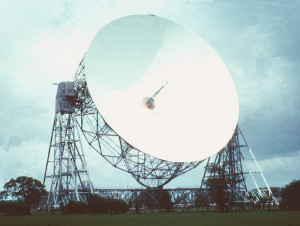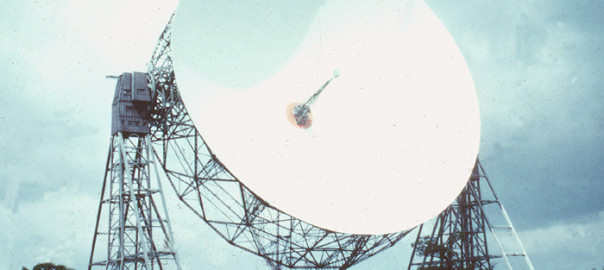
11th October – I’ve seen a few tweets today stating something along the lines of “On this day, 1957, the largest radio telescope in the world was switched on at Jodrell Bank in Cheshire.”
I don’t know where that claim originates but I’m pretty sure it’s not true.
Construction of the telescope had begun in 1952 and by 1957, it was almost complete. Here’s a timeline from 1957 based on information from “The Story of Jodrell Bank” by Bernard Lovell, founder and first director of Jodrell Bank :
- Sunday February 3rd
“Husband was anxious to measure the azimuth track friction…we had the excitement of seeing the telescope move: Only an inch, but everything was free.”
This movement in azimuth was not powered by electric motors, they had not yet been fitted. - Wednesday June 12th
“We have just seen the telescope move 20 yards – it was most exciting and the suspense was terrific! In fact at this moment it is being driven back to its original position. Everything seemed to go very smoothly.”
This was the first movement in azimuth under power. - Thursday June 20th
“The bowl has been tilted! …The transition from no movement to movement was imperceptible, the motion was superb – only a quiet hum from the motor room like a great ship…A majestic sight in the hot sun.”
This was the first movement in elevation.
Watch “Listening To The Stars”, a Pathe newsreel from 1957 June 27th. - Friday August 2nd
“…we shan’t forget August Bank Holiday 1957. On the Friday night Aug 2, we got our first recording. 160 mc/s with the bowl in the zenith…Hazard reckoned that the sensitivity was at least 6 times up on the transit telescope and Hanbury said that it was the finest record he’d ever seen.”
The first signals received by the telescope were with the telescope pointed straight up and not in movement. Although they continued with measurements through August, the drive system was not connected to the control room and the telescope was far from fully steerable. Progress was painfully slow. There were serious engineering problems with the telescope, the project faced huge debts and the Press were sniping from the sidelines. - October
“As October dawned our affairs were in such a tangle that all seemed lost… The Staff Room of the University and its environs became a most uncomfortable place for me; an onlooker might have thought that I was carrying some terrible infectious disease… We needed a miracle, it seemed, to raise us out of this bottomless pit of troubles. The miracle came – from behind the Iron Curtain in the form of Sputnik I, the world’s first artificial earth satellite.”
Despite “a state of siege” from the Press developing around the Observatory and his home following the launch on October 4th, Lovell had no intention of trying to receive the signal from the satellite itself – that didn’t need a 250-foot telescope. But in a series of phone calls from “various places in London” he learnt that there was no defence radar in the free world capable of detecting the launch rocket, an intercontinental ballistic missile – “The miracle was waiting to be grasped…Work which had previously been thought to take months was then completed in forty-eight hours”. - Wednesday October 9th
“At 6 p.m. on Wednesday 9 October the servo loop on the telescope drive was closed and for the first time the instrument was moving automatically under remote control from the control room.”
- Thursday October 10th
“A few minutes after midnight <on Wednesday evening> the telescope was transmitting to the moon and strong echoes were received on the cathode ray tube.” - Thursday October 10th
“With the latter <lunar> equipment still out of action we made our first search for the rocket during the night of 10 October with this meteor equipment. We found nothing, and later discovered that the receiver had gone out of adjustment during the transfer.” - Friday October 11th
“When the rocket was above our horizon on 11 October we tried again. This time the equipment was clearly functioning. The cathode ray tube was full of the radar echoes from meteor trails and although there was absolutely nothing to guide us as to what an echo from a rocket would look like we were reasonably satisfied that one of the responses was at such a range and of such a character that it was a response from the rocket.” - Saturday October 12th
“Just before midnight there was suddenly an unforgettable sight on the cathode ray tube as a large fluctuating echo, moving in range, revealed to us what no man had yet seen – the radar track of the launching rocket of an earth satellite, entering our telescope beam as it swept across England a hundred miles high over the Lake District, moving out over the North Sea at a speed of 5 miles per second.”
So, when was the telescope first “switched on”? Was it when it first moved, unpowered on February 3rd 1957, or under power on June 12th? Or when it first received radio signals from the Universe on August 2nd? Or should we wait until it was moving under full automatic control and used with a radar on October 10th?
If I was forced to pick, I think I’d go for August 2nd – the occasion of “first light”, always an auspicious occasion for any telescope and generally regarded as its first use.
So, despite claims circulating on the internet, I don’t think October 11th is the date the telescope was first switched on. But it was right in the middle of probably the most important week of the telescope, when it drew the attention of the world by tracking the launch rocket of Sputnik 1 at the dawn of the space age. Not a bad claim to fame!


2 responses to “When was the Lovell Telescope at Jodrell Bank first switched on?”
…and how did they know in which direction to point the bowl?
…for Sputnik rocket you mean? The orbit was known – in fact the rocket was visible to the unaided eye at night (much like the international space station and other satellites are today) e.g. see http://history.nasa.gov/sputnik/harford.html and http://claudelafleur.qc.ca/Spacecrafts-1957.html . The key point here is that it was detectable by radar.